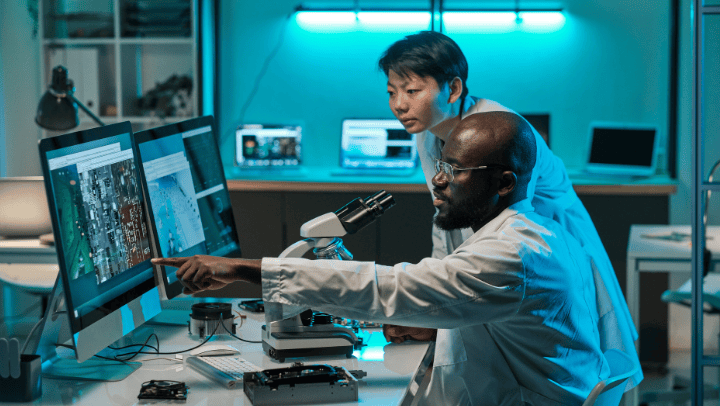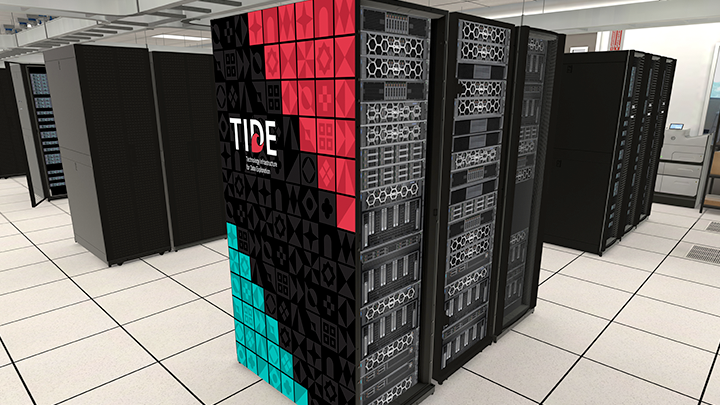SDSU upgrades network to support innovation, research
SDSU is set to achieve a groundbreaking upgrade to its main network connection, upgrading it from 100 Gbps to an impressive 800 Gbps.

Across San Diego State University, researchers and students rely on the internet for everything from sending emails to running data-intensive simulations. A fast and reliable network is essential, and this summer, it’s about to get even better.
Thanks to a partnership with the California State University Chancellor’s Office and the Corporation for Education Network Initiatives in California (CENIC), SDSU will receive a major technological boost: an 800 Gbps (gigabits per second) upgrade to its main network connection.
This upgrade will make SDSU the first university to achieve such a high level of connectivity through a single connection, setting a new standard for academic and research networks.
How fast is 800 Gbps? To put it in perspective, that’s enough bandwidth to download an entire 4K movie in seconds or stream thousands of 4K videos simultaneously. This means faster research, smoother collaboration and a network built for the future.
“These improvements are about more than just speed,” said Mike Farley, SDSU’s chief technology research officer. “They’re about giving our students and faculty the tools they need to collaborate and innovate, both here at SDSU and with colleagues around the world.”
The added network power will bolster essential operations at SDSU, such as enrollment systems, financial aid portals, and faculty communication platforms. System updates, security patches, and software installations that take several minutes may get a turbocharge. The upgrade will also increase SDSU's network capability to manage higher traffic volumes, equivalent to 32,000 students streaming 4K videos simultaneously — a boon to SDSU’s research and AI efforts.
Faster Connections for SDSU Imperial Valley
SDSU Imperial Valley, Calexico’s new connection was brought online in February, and Brawley’s will launch with its new Sciences and Engineering Laboratories, slated to open later this year. The new connections will boost internet speeds to 10 Gbps (10 gigabits per second), with the ability to go even faster in the future.
SDSU is also extending to SDSU Imperial Valley its Science DMZ, a specialized network architecture designed to optimize the transfer of extensive scientific data. This system is designed to handle large amounts of data, helping researchers work on projects like precision agriculture, environmental studies and cross-border research.
“These upgrades are a game-changer for our Imperial Valley campuses,” said James Frazee, SDSU’s Chief Information Officer. “They’ll provide the speed and reliability our students and researchers need to succeed while also preparing us for future growth.”
SDSU Imperial Valley will also continue to use backup internet through the Imperial Valley Telecommunications Authority (IVTA).
SDSU Leads the Way
This summer, SDSU will upgrade its main network connection from 100 Gbps to an impressive 800 Gbps. This upgrade uses cutting-edge technology, including 800G ZR+, which minimizes physical space and power consumption needed to support this significant increase.
SDSU's research Science DMZ will experience a dramatic speed increase in data transfers. For example, transferring a large dataset over an 800 Gbps network would take just 7.5 minutes instead of an hour. This means researchers working with massive datasets, such as those in genomics, climate modeling, or AI training, can access and analyze their data much faster as systems are implemented to support these increased speeds.
“These network upgrades are a critical investment in the success of our students, faculty, and staff,” Frazee said. “Whether it’s accessing course materials, conducting groundbreaking research or collaborating across campuses and disciplines, these improvements will enhance every aspect of university life.”
Looking Ahead
These extraordinary network upgrades are part of SDSU’s commitment to breaking new ground to provide the best possible environment for learning, teaching and research, Farley said.
For example, it will improve key systems like VERNE, a powerful computing resource used for classes, and TIDE, a tool for researchers across SDSU and other CSU campuses, Farley added. It will also support the Computational Science Research Center, helping students and faculty tackle data-heavy projects and explore new possibilities in science and technology.
“In addition, these upgrades put SDSU on the leading edge of technology, ensuring the university can continue to attract top talent and support groundbreaking projects,” Farley said. “Whether you’re a student, faculty member, or staff, these improvements will make a difference in your day-to-day work and study.”
The upgrades also build on the foundational work achieved through an NSF Campus Cyberinfrastructure grant awarded in 2012, which launched SDSU’s first Science DMZ. Jose Castillo, director of the Computational Science Research Center, led the efforts as principal investigator with Christopher Paolini serving as co-principal investigator. Their work established SDSU as a leader in Science DMZ deployment.
“We’re investing in the future,” Castillo said. “These upgrades will make SDSU a leader in research and technology, helping our students and faculty achieve amazing things.”
The upgrades connect SDSU to CENIC AIR, a networked collection of shared compute and storage made available by participating CENIC member institutions that provide advanced resources for artificial intelligence (AI) research and education across California.
CENIC is a nonprofit organization created in 1996 by California’s research and education institutions that owns, operates, and maintains an advanced fiber-based internet network for use by these institutions, including K–12 schools, libraries, colleges, and universities across California, including SDSU. CENIC plays a key role in ensuring that campuses stay connected to advanced resources for education and research.




